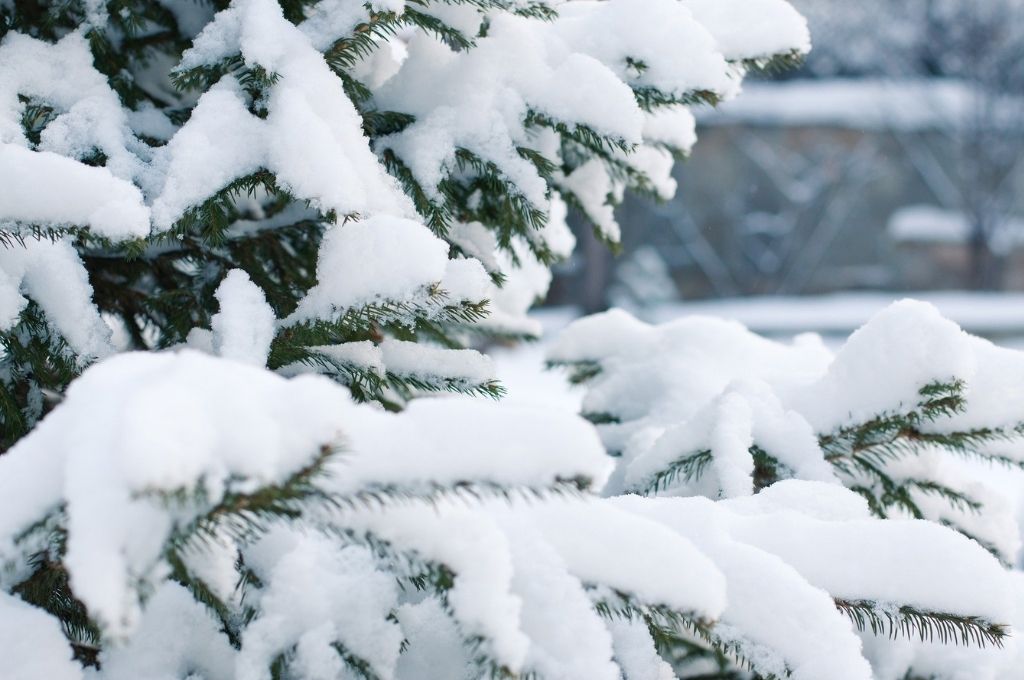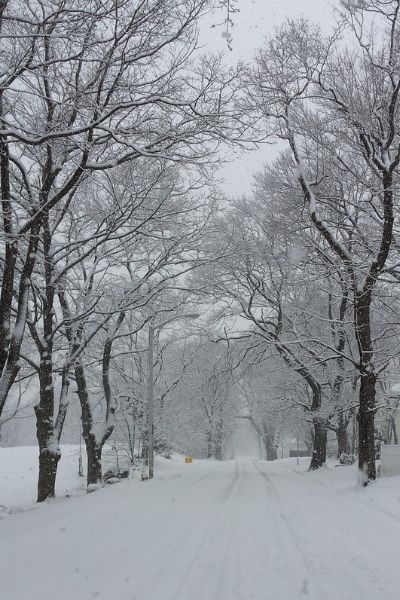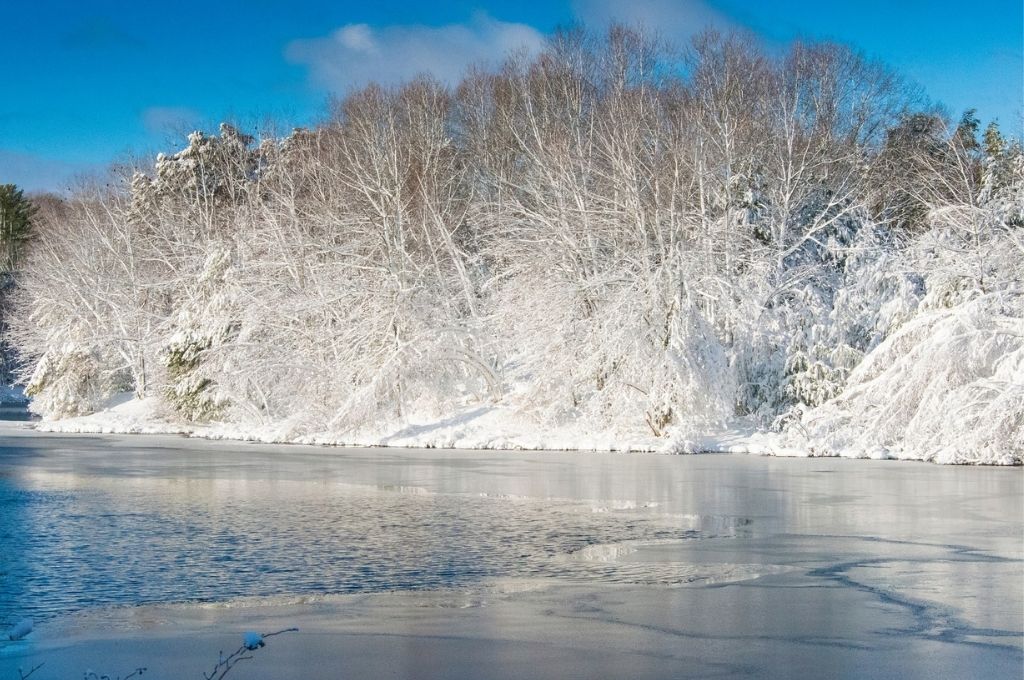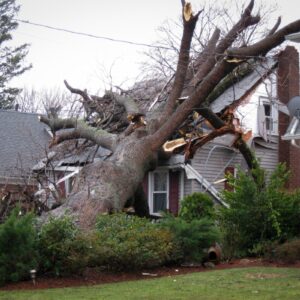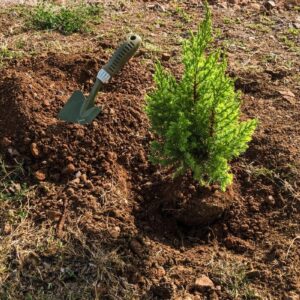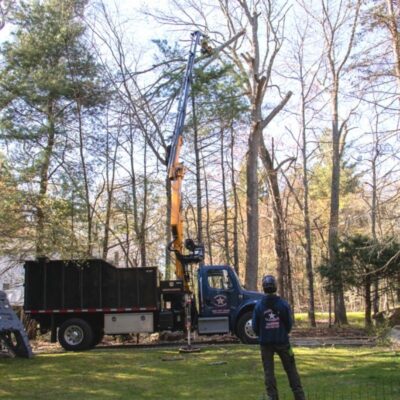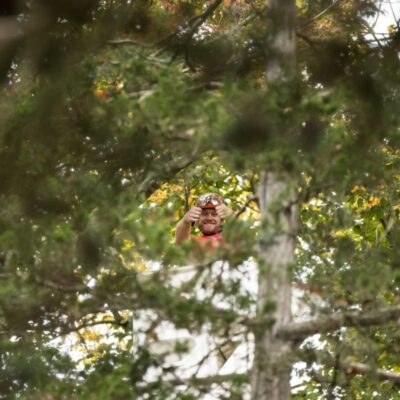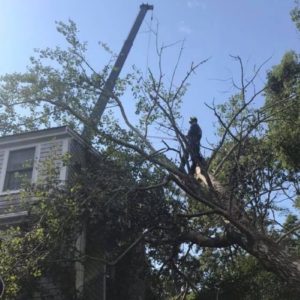When winter storms sweep through Massachusetts, they often leave behind wet, heavy snow or a thick, impenetrable layer of ice. Between the wind and the weight of snow and ice, trees and shrubs frequently break or even topple. What you do with winter storm-damaged trees, both in the short-term and after the snow melts, will affect their chance of survival, as well as their long-term health and appearance.
In this article, we help you understand how to minimize tree damage after a snow or ice storm. You’ll learn:
- How to prevent ice and snow damage to trees
- How to assess safety issues and tree damage after a winter storm
- Whether or not a tree is likely to recover
- What NOT to do with snow or ice-damaged trees
- What you can (and should) do to help your storm-damaged trees
- Which trees to avoid planting (or to provide additional protection for)
- Why patience is a virtue after a snowstorm
Prevent Ice & Snow Damage to Trees
Ice and snow are annual visitors here in Massachusetts, and each year we prepare ourselves for them with hats, gloves, winter boots, and snow shovels. Our trees naturally prepare themselves for winter by entering dormancy, but sometimes they need a little help from us.
Before winter unleashes its full force, there are several things you can do to help ensure your trees are as protected from the weather as you are!
Before winter arrives, you’ll want to:
- Evaluate your trees, especially your large trees, before the winter weather gets severe
- Determine if there are any broken, dead, or unbalanced branches that might fail when winter piles on the snow, ice, and wind
- Make sure your trees have not grown up and into overhead utility lines – nobody wants power outages on top of winter weather!
- Ensure that trees near to or over sidewalks and roads have branches pruned up and away from pedestrians and drivers. Remember: the regular height of a flexible branch will be lower when it’s weighed down with snow and ice.
And, of course, schedule needed pruning before winter’s worst weather descends! While our crews work year-round, we don’t work when extreme weather creates a dangerous situation. Plus, we may be busy with previously-booked appointments if you call for emergency tree-care services during or after a storm.
PRO TIP: If you notice any tree growth or tree damage that could cause problems later in winter, we recommend preventive or preemptive pruning. This is worthwhile because tree pruning before branch damage occurs means your trees can be pruned to enhance their natural shape rather than to mitigate damage. Anyone who’s ever had a bad haircut knows just what we mean.
After a Snow or Ice Storm
Stepping outside after a winter storm can feel magical, especially when everything is muffled under a fresh layer of snow. But when a storm has been particularly severe and snow and ice have accumulated, it’s a different story. In this case, you’ll first want to stop and evaluate your surroundings.
Safety First
Check to see:
1. If fallen tree branches or a fallen tree has blocked your driveway or the public right-of-way in front of your house.
- If it’s on your property, call a tree care professional. You probably won’t be the only person with storm damage so be prepared to leave a message and wait until the work can be scheduled. Tree service companies will be using a “triage” system to deal first with life-threatening and public safety situations, followed by cases with significant damage (such as trees that have fallen through a home’s roof), and then to downed or damaged trees without safety issues or property damage.
- Call your municipal public works department or the non-life-threatening emergency number for assistance with downed trees or branches across sidewalks or roads.
2. If utility lines are damaged or impacted by tree branches.
- If you see any damage or potential damage, call your utility company.
Assess the Damage
Take a look at all the trees on your property. If there’s any damage, some of it may be obvious but some likely won’t be; if you’re unsure, call in a tree care professional for a thorough inspection.
Common signs of tree damage after a winter storm include:
- Broken and hanging branches
- Torn bark
- Broken or damaged cabling
- Trees and branches bent under the weight of snow and/or ice
- A tree that has split apart
- A tree that’s leaning
- Broken or missing leader (the main upward branch)
- Split or cracked branches (these may not be obvious or visible from the ground)
Will the Tree Recover?
Although the damage may look bad, many tree species are quite resilient. With proper care, a healthy tree without irreparable damage will likely bounce back.
If a damaged tree meets the following criteria, it has a good chance of making a complete recovery:
- The tree was healthy before the storm struck, and
- It still has its leader, and
- It still has most of its major limbs, and
- It still has more than half of its branches.
Remove any tree that’s lost its leader or more than 50% of its branches, especially the major scaffold branches. It’s highly unlikely to survive the damage and besides, it will never look good even with extensive pruning. And no, topping a tree that’s lost its leader will not save it.
What NOT To Do After a Snow Storm
Don’t go near a tree that is in contact with utility lines, and don’t attempt to remove the tree yourself. Ice is dangerous! Electricity passes through it, people of all ages and physical conditions slip and fall on it, and only trained professionals should use power tools when it’s icy.
Don’t stand under a snow- and ice-loaded tree, even if you have a hard hat. A lot of emergency room visits are caused by underestimating risk. Let the snow and ice melt naturally and watch from a safe distance.
Don’t shake branches to get snow and ice off. Falling snow and particularly falling ice are unpredictable and heavier than you think.
Whatever you do, don’t use your hose to melt snow from branches or wash it from your sidewalk. Even a sunny, warm winter day will turn into a freezing winter night, and no one needs more ice underfoot!
What You CAN Do
You can clear ice and snow from small trees and shrubs if you can reach them from the ground. Use a broom to gently knock off snow and ice. If it doesn’t come off easily, leave it alone. Please don’t whack the branches when they’re brittle with the winter cold.
You can clear small, fallen branches from your walkways, and sweep or shovel snow to clear paths to your door.
Trees More Likely to Sustain Snow Damage
Some trees are more susceptible to winter snow and ice than others. It’s not the trees’ fault, it’s their natural growth habits.
Trees that can be more affected by winter snow and ice loads include:
- Evergreen trees often have dense crowns that catch and hold snow (unlike deciduous trees which have the advantage of bare branches that let snowfall through them). Depending on the size of the evergreen and the severity of the snow and ice, evergreen branches can bend to accommodate the weight of winter weather. But, sometimes they will break. Evergreen trees that are susceptible to snow and ice buildup include arborvitae, yews, junipers, and hollies.
- Soft-wooded trees and fast-growing trees have weaker branch strength than slow-growing hardwood trees. As a result, they’re more likely to be severely damaged in winter storms. Examples of these include Callery pear (Bradford pear), willow, birch, and poplar.
- Multi-leader trees. Trees with more than one main leader or trunk are often more likely to break from ice and snow damage. Branches often grow together at their base, developing included bark. Areas of included bark are among the most likely places for decay and branch failure.
- Fastigiate, or upright trees with more vertical branches and close branch crotches will naturally hold snow and ice more than spreading branches. Yews and juniper cultivars are common examples.
Regular pruning over the life of a tree helps shape a healthy, flexible crown that can prevent weather-related damage. But judicious pruning at any point during a tree’s life can be effective, too. Just don’t prune in the fall.
NOTE: Small upright trees and shrubs can be tied up or wrapped in burlap to keep snow and ice out of their branches, but wrapping is unrealistic for larger specimens.
Practice Patience
It may be hard to do, but the best thing for ice and snow in trees is to leave it alone. Clear skies and higher daytime temperatures will help melt snow and ice, and winds will blow loose snow away.
Likewise, if you have a large fallen tree or trees with branches broken in winter storms, you can probably leave them alone for now. If they do not pose a hazard to people or property, and are not on public land, let them stay where they are and call for an appointment to have them removed.
A storm-damaged tree that’s dormant and not in proximity to people or property just needs to be professionally pruned before bud break in the spring.
Check Your (Tree Care) List
If you have a holiday to-do list, consider adding a tree evaluation or tree pruning appointment to it. While a tree evaluation may not be festive, it is part of a preventive approach to winter storm damage. All we do is care for trees, and we know it’s easier for everyone to prune trees ahead of winter damage than try to repair them afterward. And your trees will thank you next spring by pushing out new leaves and flowers from their healthy, vigorous branches!
Blog Topics
Recent Posts
What's Happening? Stay Informed!
Stay on top of local events, pest and disease updates, tree and landscape tips, and more. Delivered straight to your inbox each month.

